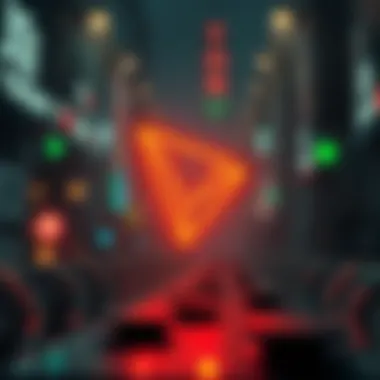An In-Depth Look at TRC20 Tokens on the TRON Blockchain


Intro
As we plunge into the realms of cryptocurrency, one particular component stands out in recent discussions: TRC20 tokens on the TRON blockchain. To fully grasp their significance, it's essential to understand the very basics of cryptocurrency and the technology that powers it. In this article, we will explore the foundational elements of TRC20, examine how it differentiates itself from other token standards, and delve into its practical implications within the vast cryptocurrency ecosystem.
Understanding Cryptocurrency
Cryptocurrency has steadily shifted from a niche market to a prominent financial phenomenon. But what exactly defines cryptocurrency?
What is Cryptocurrency?
At its core, cryptocurrency is a form of digital or virtual currency that uses cryptography for security. Unlike traditional currencies issued by governments, cryptocurrencies operate on decentralized networks based on blockchain technology. This decentralized nature ensures that no single entity has control, allowing for peer-to-peer transactions. Imagine trying to get into a club, but instead of paying with cash, you can trade a unique coin that only exists in the digital realm. That's the world of cryptocurrency!
How Does Blockchain Technology Work?
Blockchain technology serves as the lifeblood of cryptocurrencies. It's a distributed ledger system where all transactions are recorded in a secure, cryptographic format. Each block contains a number of transactions, and, once filled, it’s linked to the previous block, creating an unbroken chain. This not only helps ensure data integrity but also enhances transparency, as anyone can view the entire transaction history. Think of it like an ever-growing library where no book can be removed or altered without a trace.
As we transition to the specific topic of TRC20, understanding these foundational concepts lays the groundwork for appreciating its unique features and applications within the TRON blockchain.
Investment Strategies
Investing in cryptocurrency involves not just understanding the assets but also having a strategy in place.
Long-term vs Short-term Investments
Investors often find themselves at a crossroads between long-term and short-term strategies. While the long-term approach is akin to planting a tree and waiting for it to grow, the short-term approach can feel more like day trading, capturing frequent gains with high volatility. Each strategy has its merits, but the choice often hinges on the investor's risk appetite and goals.
Risk Management in Crypto Trading
Engagement with cryptocurrencies can be thrilling but also turbulent. Effectively managing risks is paramount. Here are some strategies:
- Diversification: Don't put all your eggs in one basket. Spread investments across various tokens to mitigate potential losses.
- Setting Stop-Losses: Determine a price point at which to sell an asset to limit losses.
- Continuous Education: Staying abreast of market trends, news, and changes in technology can inform better decision-making.
In this rapidly evolving space, understanding these strategies becomes crucial for investors, educators, or anyone interested in delving deeper into the cryptocurrency bubble.
As we move further along, we'll meanpeel the layers of TRC20, elucidating its features, applications, and what the future might hold for this token standard.
“In the world of crypto, knowledge isn't just power; it’s a currency.”
Stay with us as we draw a clearer picture of the TRC20 landscape.
Understanding TRC20
The TRC20 token standard is a significant component within the TRON blockchain ecosystem. Understanding TRC20 is crucial for anyone involved in cryptocurrency, whether you're an investor, a developer, or simply an enthusiast of digital assets. This section lays the groundwork for comprehending how TRC20 operates and why it has gained traction in the digital landscape. It enables readers to grasp the advantages, technical specifications, and the underlying philosophy behind TRC tokens.
What are TRC Tokens?
TRC tokens are digital assets that operate on the TRON blockchain, governed by the TRC20 standard. This standard plays a pivotal role in defining how these tokens behave and how transactions are executed. Essentially, a TRC20 token is analogous to an Ethereum ERC20 token but optimized for the TRON network's technology.
In practical terms, the utility of TRC tokens extends beyond mere transactions. They enable developers to create decentralized applications (dApps) with integrated economic models, facilitating a seamless user experience while promoting ecosystem growth. Notable examples include tokens like TRC10, which are often used for various applications within the blockchain. Key characteristics include:
- Decentralization: Reduces reliance on centralized authorities, enhancing security.
- Compatibility: Easy integration with existing TRON infrastructure and dApps.
- Versatility: Can be utilized for a variety of purposes, from payment methods to governance tokens.
Historical Context of TRC Standards
The emergence of TRC tokens can be traced back to TRON's commitment to creating an inclusive and decentralized internet. The TRC standards were introduced as part of TRON's roadmap, aiming to establish a framework for the digital economy while aligning with global trends in blockchain innovation.
The foundation of TRC20 was laid out in 2018, amid a surge in interest in tokenization across various platforms. This standard was designed to overcome some of the limitations posed by earlier protocols, such as ERC20 tokens on Ethereum. By offering lower transaction costs and quicker confirmations, TRC20 has positioned itself as a competitive alternative in the blockchain space.
“The TRC20 tokens signify a vital evolution in token standards, marrying efficiency with the growing need for decentralized solutions.”


Investors and developers who understand the historical context are better equipped to predict future trends related to TRC tokens. This knowledge can be a game changer, influencing investment strategies and development decisions in this fast-paced field.
Thus, comprehending TRC20's significance not only illuminates the operational mechanics of TRON but also enhances one's perspective on the future landscape of digital assets, making it a focal point for anyone serious about engaging in the blockchain sphere.
Technical Framework of TRC20
Understanding the technical framework of TRC20 is crucial for investors, educators, enthusiasts, and developers alike, as it provides the foundational elements that power this token standard on the TRON blockchain. This section delves into core components, the role of smart contracts, and interoperable capabilities, shedding light on how these facets contribute to the efficiency and effectiveness of TRC20 tokens. This knowledge is vital for leveraging TRC20's potential while also acknowledging the challenges that may arise.
Core Protocol Architecture
The core protocol architecture of TRC20 is the backbone of its function within the TRON ecosystem. This architecture is built upon a decentralized platform that allows for high throughput and low latency in transactions. Its design enables the execution of smart contracts, which are self-executing agreements with the transaction terms directly written into code. This empowers developers to create a wide variety of decentralized applications (dApps) that function seamlessly on the TRON network.
One of the standout features of TRC20's architecture is its compatibility with TRON's consensus mechanism, known as Delegated Proof of Stake (DPoS). In this setup, token holders elect a group of super representatives to validate transactions. This model not only increases security but also fosters a more democratic environment for the community, as decisions affecting the network can be made through voting.
Furthermore, the architecture is designed for extensibility, allowing for improvements without disrupting existing applications. This adaptability ensures that TRC20 can evolve with the rapidly changing landscape of digital assets.
Smart Contracts and TRC20
Smart contracts play a pivotal role in the TRC20 framework, offering automation and trust without the need for intermediaries. The TRC20 standard defines a set of rules and functions that developers must adhere to when creating tokens. This includes methods for transferring tokens, checking balances, and approving transactions. Developers can focus on innovative aspects of their projects rather than reinventing the wheel with each new token.
The use of smart contracts not only boosts efficiency but also enhances security. Once deployed on the blockchain, a smart contract cannot be altered or tampered with. This immutability ensures that token operations remain reliable, safeguarding users from potential manipulation or fraud. Moreover, these contracts can integrate additional functionalities like staking and governance features, encouraging user engagement and participation in the ecosystem.
Interoperability with Other Standards
Interoperability is an important aspect of the TRC20 framework. It allows TRC20 tokens to communicate with other token standards, such as Ethereum's ERC20. This capacity enables a fluid exchange of information and value across different blockchain networks, enhancing user experience and expanding market reach.
Several projects have arisen focusing on bridging these two ecosystems, opening the door for TRC20 tokens to be utilized on decentralized exchanges and dApps built on other platforms. Such interoperability not only attracts a broader audience but also fosters a collaborative environment where ideas and innovations can cross-pollinate.
"The adaptability and efficiency of TRC20 tokens present a unique opportunity for developers and investors in a competitive market."
For more on TRC20 and blockchain technology, consider visiting resources like Wikipedia, BBC, and TRON Community Forum.
Distinct Features of TRC20
The TRC20 standard, which operates within the TRON blockchain, presents a suite of characteristics that distinguish it from other blockchain token standards. Understanding these distinct features is crucial for anyone looking to leverage TRC20 tokens effectively in their projects or investments. The implications of these features extend beyond mere functionality, impacting broader applications such as decentralized finance, gaming, and asset management.
Transaction Efficiency
Transaction efficiency is a hallmark of TRC20 tokens, driven by the underlying architecture of the TRON blockchain. The protocol facilitates rapid transactions, allowing a high number of operations per second. In practical terms, this means that users do not experience the sluggishness often found in older blockchain systems.
For instance, the TRON network boasts transaction speeds that can reach 2000 transactions per second. Such efficiency dramatically enhances user experience—whether one is transferring tokens or engaging in decentralized applications (dApps). It is paramount for applications that thrive on real-time interactions, such as gaming platforms or trading exchanges, where delays can cause lost opportunities.
Additionally, real-time updates on transaction status keep users informed, creating a seamless environment compared to many legacy systems. This efficiency doesn't merely cater to whimsical use cases; it plays a pivotal role in performance-critical applications, ensuring they remain responsive and engaging.
Low Transaction Costs
When it comes to financial transactions, one of the most appealing aspects of TRC20 tokens is their low transaction costs. The TRON blockchain operates with a fee structure that is significantly lower than many other networks, such as Ethereum. By utilizing a delegated proof-of-stake consensus mechanism, transactional fees tend to hover around a fraction of a cent.
This cost-effectiveness encourages a broader range of users and developers to participate in the ecosystem. Businesses and individual users alike benefit from reductions in operational costs. Imagine a gaming platform where microtransactions occur frequently; lower transaction fees make it feasible to engage in small-scale purchases—thus, enhancing user engagement. With low barrier to entry, the TRC20 standard opens avenues for widespread adoption across various sectors.
High Scalability
Scalability is a critical concern in the ever-evolving landscape of cryptocurrencies. TRC20 tokens excel in this regard, exhibiting a scalability that accommodates an increasing number of users and transactions without a hitch. The underlying TRON architecture is designed for growth, ensuring it can handle an expanding ecosystem.
Scalability becomes particularly vital during surges in activity, such as new launches or significant market events. Unlike some platforms that buckle under high demand, TRC20 maintains consistent performance. This capacity for scalability invites innovative applications—anything from complex decentralized finance protocols to NFT marketplaces can flourish without concern for network congestion.
In summary, characteristics such as transaction efficiency, low costs, and high scalability define the TRC20 experience. Each feature serves to dissolve obstacles that typically hinder adoption and fosters an environment conducive to continued growth and innovation in the cryptocurrency space.
"With the right features, TRC20 tokens are well-positioned to cater to the future needs of a diverse blockchain ecosystem."
For more in-depth analysis and resources related to the TRON blockchain and TRC20 standards, consider visiting Wikipedia, Britannica, or engaging with communities on platforms like Reddit.


Comparison with ERC20
When we dive into the landscape of token standards, a comparison between TRC20 and its Ethereum counterpart, ERC20, becomes crucial. Understanding these distinctions not only reveals the advantages of TRC20 but also illustrates the broader implications for investors and developers alike.
Technical Differences
One of the most significant areas where TRC20 and ERC20 diverge is in their technical frameworks. While both standards facilitate the creation of tokens, they operate on different blockchains—TRC20 runs on TRON, while ERC20 is embedded within Ethereum's ecosystem.
- Consensus Mechanism: TRON employs a Delegated Proof of Stake (DPoS) framework, which fosters higher transaction speeds and enhanced scalability compared to Ethereum’s Proof of Work (PoW) mechanism. This means that TRC20 tokens can be processed much quicker, handling thousands of transactions per second.
- Smart Contract System: The syntax of TRC20 smart contracts is similar to that of ERC20, but the execution environment differs substantially. TRC20 contracts often have reduced gas fees because of the efficient infrastructure of the TRON network, whereby users can enjoy more favorable conditions when deploying or calling contracts.
- Token Supply: In a practical sense, creating a TRC20 token incurs fewer restrictions regarding total supply and distribution protocols, granting developers more flexibility in managing tokenomics compared to ERC20 tokens. This flexibility can be advantageous during initial launches.
These technical disparities present developers and investors with distinct choices based on their priorities, whether it may be scalability, costs, or customization in their projects.
Market Adoption
The differences in technology inevitably lead to variations in market adoption. Historically, ERC20 tokens have dominated the blockchain landscape since Ethereum’s inception. Many cryptocurrencies and projects like Chainlink and Tether came into existence through ERC20, leaving TRC20 in the rearview mirror of mainstream visibility.
Nevertheless, TRC20 tokens have gained traction, especially due to the substantial user base of the TRON platform and its focus on streaming content and decentralized applications.
- Adoption Rate: The TRON network has seen rapid user growth, attracting developers seeking a more cost-efficient platform. Token projects like Just (JST) and TRON’s own native stablecoin, Tether on TRON, showcase practical implementations of TRC20 tokens in the market.
- Community Engagement: The vibrant community around TRON actively engages with these tokens, thus fostering a supportive ecosystem. This engagement encourages more projects to explore the TRC20 standard as a viable alternative, potentially leveling the playing field against ERC20 over time.
- Use Cases: Key areas such as gaming and decentralized finance (DeFi) are emerging as hotspots for TRC20 tokens, with successful initiatives like WINk and TRONbet capturing significant attention. As user interest swells around these applications, the likelihood of TRC20 gaining a foothold increases.
Real-World Applications of TRC20 Tokens
The real-world applications of TRC20 tokens underline their significance within the TRON blockchain ecosystem. By demonstrating how these tokens function beyond mere speculative assets, we can visualize their potential to effectuate real changes in various sectors. This discussion serves as a key foundation for understanding the broader implications of TRC20 tokens in digital finance, while characterizing their practical use cases.
Decentralized Applications
Decentralized applications, often called dApps, leverage the advantages of blockchain technology, allowing for seamless user interactions without any intermediaries. TRC20 tokens play a pivotal role in these platforms. Developers harness TRC20 to create solutions ranging from social networks to financial services, extending possibilities for user engagement and transaction processing.
Many dApps built on TRON utilize TRC20 tokens for in-app purchases or rewards. For instance, a digital marketplace could enable users to transact using TRC20 tokens for purchasing virtual goods, ensuring lower fees and higher transaction speeds compared to traditional methods. Moreover, dApps can incentivize user participation through token rewards, creating a more engaged community. The scalability of the TRON network directly matches the growing demand for efficient dApps, allowing projects to gain traction at a rapid pace.
Gaming and NFTs
The gaming industry is undergoing a significant shift, increasingly incorporating blockchain technology. Using TRC20 tokens within gaming ecosystems allows developers to create intricate economies where players can earn, buy, and trade virtual goods effortlessly.
For instance, a game could implement TRC20 tokens to facilitate player-to-player transactions. Players can buy skins or upgrade features without hefty fees, enhancing user experience. Additionally, non-fungible tokens (NFTs) are revolutionizing how digital assets are perceived; they can now represent ownership of unique in-game items. The flexibility of TRC20 tokens makes them perfect for such applications, as they can be used in trading platforms that support NFT creation and sale.
Stablecoins and Payment Solutions
The push for stablecoins has grown, driven by the need for a less volatile medium of exchange in the cryptocurrency domain. TRC20 tokens can serve as a reliable foundation for developing stablecoin solutions. By pegging TRC20 tokens to traditional currencies or commodities, projects can offer the benefits of blockchain—speed, transparency, and security—while maintaining price stability.
Payment solutions leveraging TRC20 tokens can streamline transactions for various businesses. By employing these tokens, merchants can accept payments with minimal fees and faster settlement times when compared to conventional banking. This transition allows small business owners and entrepreneurs to remain competitive in an increasingly digitized economy. Discovering the practical applications of TRC20 tokens in payment solutions opens doors for further integrations into mainstream financing and commerce.
"Emerging technologies like TRC20 represent the next wave in the evolution of digital finance, providing innovative solutions that traditional models can only dream of."
As we continue to explore the applications of TRC20 tokens, it becomes increasingly evident that these tokens are not merely hypothetical constructs. Instead, they represent a rich ecosystem with real-world implications that could reshape industries for the better. Understanding these applications will help stakeholders fully appreciate the value and potential these tokens hold in various sectors.
Benefits of Using TRC20 Tokens
The significance of TRC20 tokens lies not just in their functionality but also in the broader implications they hold for users and the TRON ecosystem as a whole. In this section, we will explore two primary benefits of these tokens: enhancing user experience and promoting growth within the ecosystem.
Enhanced User Experience
One of the standout features of TRC20 tokens is their intuitive user experience. When individuals interact with TRC20 tokens, they often find the process to be straightforward and seamless. Most wallets that support TRC20, like TronLink or JustLend, are designed with user-friendliness in mind, allowing for easy asset management.
Unlike some other token standards, TRC20 focuses on speed. Transactions can occur in the blink of an eye, significantly enhancing user satisfaction. This becomes especially critical in contexts where time is of the essence, such as trading or engaging in decentralized applications. Not only does this reduce frustration, but it also encourages more users to get involved with TRC20 tokens.
Moreover, because TRC20 tokens leverage the TRON blockchain, they benefit from low transaction fees. Users don’t need to worry about excessive costs eating into their transactions, thus making the experience more economical. This low-cost solution makes TRC20 tokens an attractive option for newcomers to cryptocurrencies who might be hesitant due to high fees associated with other platforms.
Ecosystem Growth Incentives
TRC20 tokens play a pivotal role in the economic framework of the TRON ecosystem. Their design is not only about enhancing user experience but also pushing for sustainability and growth within the platform. Here’s how these tokens contribute:


- Reduced Barriers to Entry: New developers can easily create and deploy tokens on the TRON network, encouraging innovation and diversification. This leads to a rich variety of applications and services available to users.
- Incentive Structures: Many projects built on TRC20 tokens implement reward systems, such as staking or yield farming, which encourage users to hold their tokens instead of selling them. This practice not only fosters community engagement but also helps stabilize token value.
- Integration with Other Projects: The TRC20 standard fosters interoperability between various applications. This connectivity allows decentralized applications to leverage a common token standard, stimulating collaborative growth.
The synergy among projects enhances the ecosystem, allowing users to transition smoothly between different platforms, ultimately increasing total transaction volume and boosting activity on TRON.
Challenges and Limitations
The exploration of TRC20 tokens on the TRON blockchain cannot be fully understood without addressing some of the formidable challenges and limitations that exist within this technology landscape. Recognizing these issues is essential for investors, educators, and developers who wish to navigate this complex environment. Through a nuanced understanding of these challenges, stakeholders can make more informed decisions while strategizing on future developments.
Market Competition
In the realm of cryptocurrency, it’s a dog-eat-dog world. TRC20 faces stiff competition not only from tokens built on other platforms, such as Ethereum’s ERC20 but also from a myriad of newer standards. With thousands of cryptocurrencies in circulation, distinguishing one token from another often boils down to their specific use cases and the ecosystems supporting them.
For example, while TRC20 tokens tout lower transaction fees and faster processing times, other token standards may present unique advantages. Ethereum remains a mainstay due to its pioneering smart contract functionality, which has cultivated a substantial developer community. Similarly, newer chains like Solana and Avalanche offer robust performance metrics that attract both users and developers alike. The crowded market necessitates strategic differentiation for TRC20—whether through enhancing technological frameworks or building strategic partnerships.
Key points include:
- User Adoption: Attracting a user base in such an oversaturated space is challenging.
- Technology Versatility: Other platforms might provide more comprehensive tooling for developers.
- Brand Recognition: Established names carry weight, and TRON must continue to build its reputation to compete effectively.
"In a world where everyone is shouting, sometimes it’s the subtle whispers that capture attention."
Regulatory Considerations
Regulatory frameworks are becoming increasingly important in the cryptocurrency realm, often acting as a double-edged sword. On one side, clear regulations can establish legitimacy and protect investors; on the flip side, excessive regulations might stifle innovation and limit the scope of projects within networks like TRC20.
The handling of cryptocurrencies varies widely by jurisdiction. Some countries embrace blockchain technology, while others impose stringent regulations or outright bans. This regulatory confusion creates uncertainty, making it difficult for developers and investors to plan for the long term. If a significant shift occurs in regulations, TRC20 may find itself at a crossroads. Key areas of concern include:
- Compliance: Adhering to local laws can complicate the deployment of TRC20 projects.
- Tax Implications: How tokens are categorized could lead to different tax obligations, which could hinder investment.
- Investor Protection: While regulations aim to safeguard investors, they can also impede innovation by enforcing onerous requirements on new projects.
In summary, while there’s vast potential in TRC20 tokens, understanding the wider challenges—markedly market competition and regulatory considerations—can provide clarity in navigating this ever-evolving landscape. When looking to the future, it’s vital to keep eyes on both the opportunities and obstacles that lie ahead.
The Future of TRC20 Tokens
As the cryptocurrency landscape evolves, the future of TRC20 tokens presents a fascinating arena for investors, developers, and enthusiasts alike. Understanding the potential trajectory of these tokens can shed light on their sustainability, adaptability, and relevance within a fast-changing marketplace. The TRC20 standard, as an integral part of the TRON blockchain, is poised to play a pivotal role in shaping the interactions among digital assets in upcoming years.
Emerging Trends
In recent months, a number of trends have begun to emerge in the space surrounding TRC20 tokens. These trends signal a shift towards increased functionality and mainstream acceptance. One such trend is the integration of TRC20 tokens in decentralized finance (DeFi) systems. With the growing number of DeFi projects launching on the TRON blockchain, TRC20 tokens are increasingly being adopted as collateral for lending and liquidity protocols. This trend signifies a maturation of the TRC20 ecosystem, where tokens move from mere digital assets to functional financial instruments.
Moreover, the rising popularity of Non-Fungible Tokens (NFTs) has spilled over to TRC20 tokens, as creators and artists look for platforms that allow for easy trading and transaction management. The support of TRC20 tokens in various NFT marketplaces can facilitate smoother exchanges and broaden the appeal of TRON’s capabilities.
Potential Innovations
Innovation within the TRC20 framework holds vast potential. Developers are constantly exploring novel ideas to enhance token utility and security, which could significantly alter the way users interact with these assets. One promising innovation could be the implementation of cross-chain functionality. By enabling TRC20 tokens to interact seamlessly with other blockchain standards like ERC20, it would enhance liquidity and broaden market access. Users could, therefore, tap into resources across different platforms, making their holdings much more versatile.
Furthermore, the integration of advanced governance mechanisms might revolutionize how TRC20 tokens operate. Suppose token holders can vote on decisions directly related to a project's future or token utility via decentralized autonomous organizations (DAOs). In that case, this could pave the way for more democratic and user-focused developments.
As the TRC20 ecosystem continues to foster innovation and adopt emerging trends, it is clear that the tokens are not just a passing phase but a cornerstone of future digital financial landscapes.
"The more we play with ideas surrounding TRC20, the better equipped we become to adapt to novel challenges and market demands."
Such insights into future trends and innovations not only highlight the growing importance of TRC20 tokens but also serve as a reminder for stakeholders to remain vigilant and proactive in their strategies for navigating this dynamic environment.
For further insights and trends surrounding blockchain technology, you can explore sources like Wikipedia or community discussions on Reddit.
Engaging with these platforms can provide a deeper understanding of not just TRC20 tokens, but also the broader implications of blockchain technologies.
Epilogue
In summary, the discussion surrounding TRC20 tokens brings to light several crucial aspects that extend beyond mere technical specifications. It's not just about understanding how TRC20 works, but also recognizing its significance within the ever-evolving landscape of cryptocurrency.
The importance of TRC20 cannot be overstated. These tokens form the backbone of the TRON ecosystem, facilitating interactions and transactions that drive various applications—from decentralized finance to entertainment platforms. As the digital currency sector grows, TRC20 tokens emerge as effective tools for developers and investors alike, enabling innovative solutions tailored to diverse needs.
Summarizing Key Insights
- Widespread Applications: TRC20 tokens are utilized across various sectors such as gaming, finance, and NFTs. Their versatility allows for the creation of seamless experiences in diverse environments.
- Technical Superiority: Compared to their ERC20 counterparts, TRC20 tokens offer robust transaction speeds and lower costs, a crucial factor in user adoption and retention.
- Evolving Challenges: While the TRC20 framework provides numerous benefits, challenges remain. Market competition and regulatory landscapes continue to shape the way these tokens are adopted and utilized.
- Future Potential: With emerging trends in blockchain technology, TRC20 tokens have a promising future. Anticipated innovations may lead to even greater scalability and efficiency, enhancing their usability in everyday transactions.
"The growth of TRC20 tokens reflects not only technological advancements but also a shift in how digital assets can empower users and developers."







